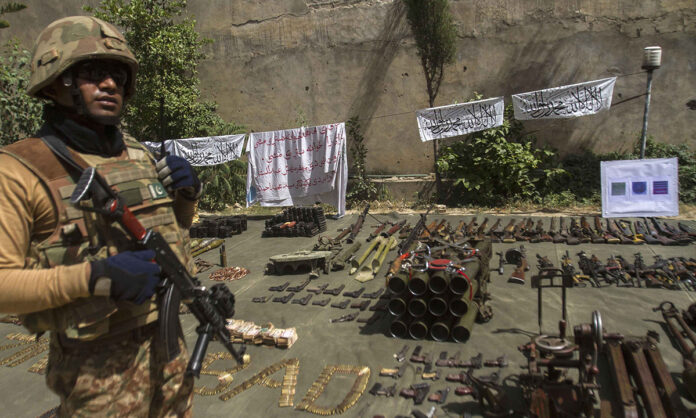America’s Lost Weapons Pakistan’s New War

The ghosts of a foreign war have come home to haunt Pakistan. Shrouded in the darkness with a perfectly clear vision, the militants are now spreading terror along the shadowed borders of Balochistan and Khyber Pakhtunkhwa. Insurgents themselves are now armed with advanced American night vision goggles, thermal optics, and automatic rifles; previously issued to U.S. supported Afghan forces, which have transformed the mountainous border regions of the militant groups, the Tehrik-i-Taliban Pakistan (TTP), into bloody battlefields. In the cruel irony of fate, weapons to fight terror are feeding it instead.
But those wheels began to come off back in August 2021 when the United States hustled out of Afghanistan and ended its two decades of war. Intended to be temporary, the group instead found itself in a six-month long chaos that resulted in tens of thousands of U.S. supplied weapons, vehicles and tactical gear left behind. These arms were to be for the Afghan National Defense and Security Forces, a military that folded almost overnight. Power and firepower were redistributed across the region as a result. Taliban quickly took control, and the mighty arsenals subsequently started trickling into the porous Afghan-Pakistani border.
An investigation by the Washington Post’s April 13, 2025 shows the deadly consequences of that military oversight. The report draws on Pentagon records and interviews with Pakistani government officials and shows that U.S. weapons have become the main edge in a new, brutal leg of militancy in Pakistan. While the impact is quantifiable in the number of Pakistani soldiers and police officers who have been ambushed and killed, many in the dead of night when the advantage of American made night vision technology becomes undeniable, it is hardly theoretical.
It is not the first-time questions have been raised about the Iron Brotherhood of the Frontier Corps; elite units in the Pakistani military that have long been regarded as among the most disciplined in the region. They fight not because of training, numbers, or willpower but because at the moment, their adversaries have the superior technology. Insurgents have both range and reliability with M4 and M16 rifles, alongside precision and endurance. Thermal optics paired with drones help them keep their distance and then follow movement, plan ambushes and disappear before any more meaningful counteroffensive can be launched. This was a modern insurgency, upgraded with all of the best gear that American military possessed.
Looking into the origins — and those origins turn out to be disturbing. Serial numbers from caches recovered from body frame of American EM12 in Pakistan, seized in Pakistani military operations during IC 2008, have been directly matched with American transfer records under Freedom of Information Act (FOIA) requests. Some of these weapons were logged as part of US military aid packages to Afghanistan, including in 2019 or 2020. The story of how American factories exported their journey to Afghan bases and further into the hands of some groups, the TTP and the Baloch separatists, is a story of systemic failure and regional neglect.
The consequences are felt in and outside the battlefield, reaching all the way to the political and diplomatic corridors of Islamabad. The more vocal Pakistani officials become, the more frustrated they are with this, pointing out that their country has more than its share of America’s war fallout. As Washington obsesses about global rivalries and its own politics, Pakistan continues to deal with violence on its soil, violence that is armed after a fashion by one of its supposed allies.
It is no more one insurgent group or one region. U.S. arms have brought new life to the long simmering Baloch insurgency by making tactical capabilities available to separatist factions that have not been reachable before. The continued terror has stretched Pakistan’s overburdened security apparatus.
A thriving weapons market is further adding to the crisis in Darra Adamkhel, which is a town on the edge of the country’s borders. Notorious as a black-market hub since the days of its invention, these places are said to be now filled with American military hardware. As M4 rifles were sold like Kalashnikovs used to be — easily. The commercialization of American arms has not only emboldened militant neighbors but it has caused instability along the region’s borders to ripple.
Attempts at accountability of the Taliban regime in Kabul have largely been symbolic. Although Afghan Taliban leadership officially denies providing arms or shelter to the TTP, The Washington Post cites a United Nations report with substantial evidence to the contrary. Interviews and intercepted communications indicate that weapons are indeed being passed among Taliban ranks, benefiting lower level fighters who, according to captured Taliban, are selling them illegally to their ideological cousins in Pakistan.
Despite that, an international response has been muted. Pakistani officials have pleaded in vain, and despite mounting evidence, nothing has been done to stop sending arms or force the Taliban government into action. The situation is proof that foreign intervention comes with long term costs lest there is accountability. Not only did U.S. weapons left behind in haste outlive their mission, they have turned it around. Rather, they put at risk a fragile regional balance instead of defending democracy.
Civilians, too, feel the cost. Schools are closed intermittently, checkpoints are more frequent, and as the sun sets, silence strikes, but it is never full; the crack of gunfire comes too often. Anxiety is where the state cannot guarantee safety.
As technological superiority and militant resurgence converge in Pakistan, now plaguing both south and north of the Khyber Pass with violence, a question keeps seeping through, whoever is responsible? The weapons that may have been lost in Kabul will spill over from Kabul and bleed across borders and reshape the security landscape of South Asia in ways that could last generations. Unless there is urgent creation of international engagement, tighter controls and real accountability, this deadly advantage will continue to weigh not towards peace, but towards continued chaos.











